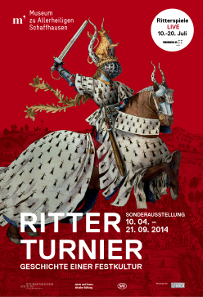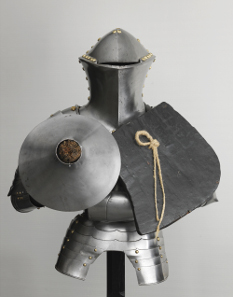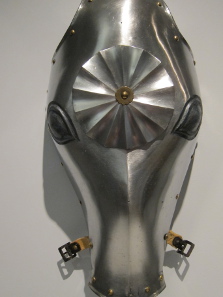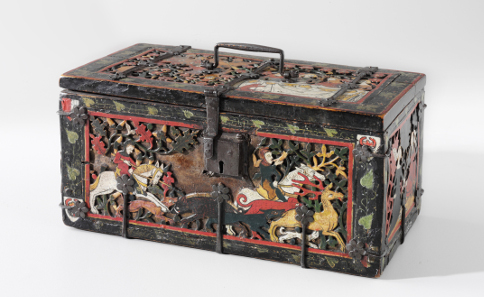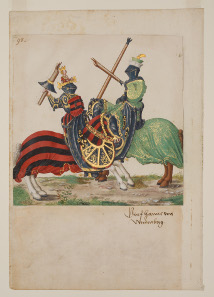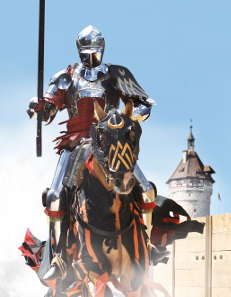by Ursula Kampmann
translated by Teresa Teklic
May 15, 2014 – Between 1431 and 1449, the Council of Basel attracted many powerful delegates to the city at the Rhine knee. Now and then, congress visitors want to be entertained (especially if the congress lasts several years). Hence many delegates made use of the opportunity to visit the fairly nearby city of Schaffhausen, venue of a large tournament between 1436 and 1438. Among the away fans were two Spaniards. They left extensive written records to the posterity so that the tournaments of Schaffhausen are the best documented joustings we know of. Reason enough for Dr. h.c. Peter Jezler, director of the Museum zu Allerheiligen, to host an exhibition on the topic. And once again, he has done an excellent job. The visitor truly undertakes a journey into the past and selected objects create an authentic experience of what it was like to attend a tourney in this epoch.
Exhibition poster.
You’re asking why this would be relevant for a numismatist? Well, quite simply, because numerous coins from the Early Modern Period portray rulers in shiny armour. If you ever wondered why princes and dukes still presented themselves in heavy, terribly uncomfortable armour at a time when wars were won by canons, not swords, the answer is that the portraits didn’t symbolise military leadership, but athletic prowess.
Probably the most famous ‘tournament coin’ in the history of numismatics: the guldengroschen of Sigismund, Archduke of Austria.
Take the famous guldengroschen of Sigismund of Austria. On the reverse, he presents himself on horseback and with crested helmet, entering the tourney.
The Stechzeug of Sigismund, Archduke of Austria, from 1483/4. © Kunsthistorisches Museum Wien, Hofjagd- und Rüstkammer.)
And the original Stechzeug of that numismatically innovative ruler can be viewed in the exhibition! Of course Sigismund possessed more than one armour for the games, but I just really like the idea that it’s this particular armour which is depicted on the guldengroschen.
If you take a closer look at the knight’s armour on such an early modern coin, the exhibition will tell you exactly why this rosette and that hook are arranged the way they are. And it is precisely the organisers’ passion for detail and specialised knowledge which brings the past alive in this exhibition.
Did you know, for instance, that the impact of the lance on the plate armour happens at 60 km/h? Can you even imagine the force at that speed? Why don’t you watch this clip which demonstrates what happens to a car when it crashes into a wall at 50, 70 and 90 km/h.
How did you prevent riders from suffering severe head concussions if they were unhorsed?
Hat worn underneath the helmet, from Sigismund of Austria, 1484. Photo: UK.
Well, they wore padded hats underneath the helmet that absorbed the shock to a great extent.
And how did you manage to keep the saddle in place despite the massive impact of the lance hitting you? And once hit, how did you prevent riders from getting stuck on the saddle one way or other and consequently contracting serious injuries?
Saddle with girth. Photo: UK.
In this context, the saddle’s form was crucial. It was flat and lacked the usual cantle. When unhorsed, the rider slid down more or less elegantly. Two straps (saddle girth) fixed the saddle securely on the horse back. The stirrups were attached far at the front which allowed the rider to lean forward and assume a more apt position to absorb the shock and stay on horseback.
Chanfron. Photo: UK.
The chanfron made it practically impossible for the horse to see the opponent on riding up and thus prevented it from bolting.
The press conference at the Museum zu Allerheiligen was well attended by TV, radio and press. Photo: UK.
Of course tournaments weren’t only athletic, but also major social events. Apart from the jousting, tribunals, banquets and dances formed an integral part of the tourneys. This was the time and place to settle old feuds, arrange marriages and introduce young people to the court etiquette.
Jewellery box decorated with scenes of chivalric life around 1320. © Zürich, Schweizerisches Nationalmuseum.
Tournaments also provided women with the opportunity to demand justice if they had been wronged – and to do so in a rather violent way. This is another one of the exhibition’s strengths: it offers concrete examples to illustrate prevalent legal concepts in the 14th century. We learn that there were certain actions a woman could take to report a rape and bring it to the trial, even if the rapist denied the offence. But at the time, this meant ordeal by trial and nothing more. The two opponents were granted trial by combat. In order to outbalance the woman’s weaker physique, the man had to fight standing in a pit up to the waist and with one hand tied to the waist. According to historical records (and quite unsurprisingly), men were never guilty, as they always came out from this “even” fight victoriously.
‘Freydal’: Tournament book of Holy Roman Emperor Maximilian I, around 1515. © Kunsthistorisches Museum Wien, Hofjagd- und Rüstkammer.
To read up on the historical background, I can strongly recommend the purchase of the highly informative catalogue, published by Quaternio (Lucerne) and available in the museum’s shop for 46 CHF. In Germany, the book can be ordered from book-sellers for 39.80 euro.
A short note to those who still want to know more about numismatic aspects of this epoch: you may want to have a look at the exhibition catalogue of another, thematically related exhibition which is currently taking place in Mannheim. The exhibition “Kaiser Maximilian I. – Der letzte Ritter und das höfische Turnier” (“Emperor Maximilian I – The last knight and the court tournament”) runs until November 9, 2014. The catalogue was published by Schnell + Steiner and includes an excellent entry on the so-called schautaler or presentation taler of Maximilian I, written by Viennese numismatist Heinz Winter.
Tournament in Schaffhausen.
However, there’s one thing Schaffhausen has that Mannheim doesn’t: the original tournaments staged in Schaffhausen between July 10 and July 20, 2014. Organisers are cooperating with the best knights there are today. Yes, they still exist, people who dedicate an incredible amount of time and effort to learning how to joust properly and face their opponents in the arena with real lances. I was fortunate enough to catch a glimpse of this skill in Sankt Wendel a few years ago – and was completely overwhelmed. You can read the whole article in CoinsWeekly.
So my recommendation goes out to all readers of CoinsWeekly who’ve always secretly dreamt of leading the adventurous life of a knight to plan a very special summer holiday this year. First to Schaffhausen to see the exhibition, then to the tournament, perhaps a few day-trips nearby to one of the many destinations that bear witness to the knightly past and, last but not least, to Mannheim to see the “last knight” in the local exhibition.
More about the exhibition in Schaffhausen here.
This is a video about the exhibition (in German).
You can get tickets and information on the tournament here.
The visitor centre in Schaffhausen also provides attractive offers in combination with overnight stays.
Click here if you want to know more about the exhibition in Mannheim.
And there is more to see in Schaffhausen, for instance the Ebnöther collection presented by CoinsWeekly.




